
Am Fam Physician. 2010;82(1):61-68
Author disclosure: Nothing to disclose.
Gait and balance disorders are common in older adults and are a major cause of falls in this population. They are associated with increased morbidity and mortality, as well as reduced level of function. Common causes include arthritis and orthostatic hypotension; however, most gait and balance disorders involve multiple contributing factors. Most changes in gait are related to underlying medical conditions and should not be considered an inevitable consequence of aging. Physicians caring for older patients should ask at least annually about falls, and should ask about or examine for difficulties with gait and balance at least once. For older adults who report a fall, physicians should ask about difficulties with gait and balance, and should observe for any gait or balance dysfunctions. The Timed Up and Go test is a fast and reliable diagnostic tool. Persons who have difficulty or demonstrate unsteadiness performing the Timed Up and Go test require further assessment, usually with a physical therapist, to help elucidate gait impairments and related functional limitations. The most effective strategy for falls prevention involves a multifactorial evaluation followed by targeted interventions for identified contributing factors. Evidence on the effectiveness of interventions for gait and balance disorders is limited because of the lack of standardized outcome measures determining gait and balance abilities. However, effective options for patients with gait and balance disorders include exercise and physical therapy.
Gait and balance disorders are among the most common causes of falls in older adults1–4 and often lead to injury, disability, loss of independence, and limited quality of life.1–8 Gait and balance disorders are usually multifactorial in origin and require a comprehensive assessment to determine contributing factors and targeted interventions.6–14 Most changes in gait that occur in older adults are related to underlying medical conditions, particularly as conditions increase in severity, and should not be viewed as merely an inevitable consequence of aging.6,10,11,15 Early identification of gait and balance disorders and appropriate intervention may prevent dysfunction and loss of independence.
| Clinical recommendation | Evidence rating | References |
|---|---|---|
| Gait and balance disorders are usually multifactorial in origin and require a comprehensive assessment to determine contributing factors and targeted interventions. | C | 6, 8, 12–14 |
| Older adults should be asked at least annually about falls. | C | 4, 27–30 |
| Older adults should be asked about or examined for difficulties with gait and balance at least once. | C | 4, 27–30 |
| Older adults who report a fall should be asked about difficulties with gait and balance, and should be observed for any gait or balance dysfunctions. | C | 4, 27–30 |
| Exercise and physical therapy can help improve gait and balance disorders in older adults. | B | 48, 49, 59–63 |
At least 30 percent of persons 65 and older report difficulty walking three city blocks or climbing one flight of stairs, and approximately 20 percent require the use of a mobility aid to ambulate.16 In a sample of noninstitutionalized older adults, 35 percent were found to have an abnormal gait.12 The prevalence of abnormal gait increases with age and is higher in persons in the acute hospital setting and in those living in long-term care facilities.6,12,17 In one study, gait disorders were detected in approximately 25 percent of persons 70 to 74 years of age, and nearly 60 percent of those 80 to 84 years of age.12
Changes in Gait with Aging
Determining that a gait is abnormal can be challenging, because there are no clearly accepted standards to define a normal gait in an older adult.10 Studies comparing healthy persons in their 70s with healthy persons in their 20s demonstrate a 10 to 20 percent reduction in gait velocity and stride length in the older population.18,19 Other characteristics of gait that commonly change with aging include an increased stance width, increased time spent in the double support phase (i.e., with both feet on the ground), bent posture, and less vigorous force development at the moment of push off. These changes may represent adaptations to alterations in sensory or motor systems to produce a safer and more stable gait pattern.
The term “senile gait disorder” has been used to describe disturbances in gait in older persons when an underlying disease cannot be identified. It is characterized by a slow, broad-based, shuffling, and cautious walking pattern.20 However, current understandings of gait disorders challenge this term because most major changes in gait and balance are attributable to one or more underlying conditions. Up to 20 percent of older adults maintain normal gait patterns into very old age, reinforcing that aging is not inevitably accompanied by disordered gait.12,13 Senile gait patterns may actually represent an early manifestation of subclinical disease, because their occurrence correlates with increased risk of cardiovascular disease, dementia, institutionalization, and death.12,17,21
Causes
Medical conditions associated with gait and balance disorders are listed in Table 1.6,10,11,22,23 They may contribute to gait and balance disorders for a variety of reasons, such as causing pain, dyspnea, imbalance, diminished strength, limited range of motion, poor posture, decreased sensory perception, fatigue, deformity, and decreased awareness of and ability to adapt to and traverse through possibly hazardous surroundings. In addition, recent surgery or hospitalization and other acute medical illnesses may lead to gait and balance disorders. The use of multiple medications (four or more), as well as specific classes of medications, can lead to gait disorders and an increased rate of falls.24–26
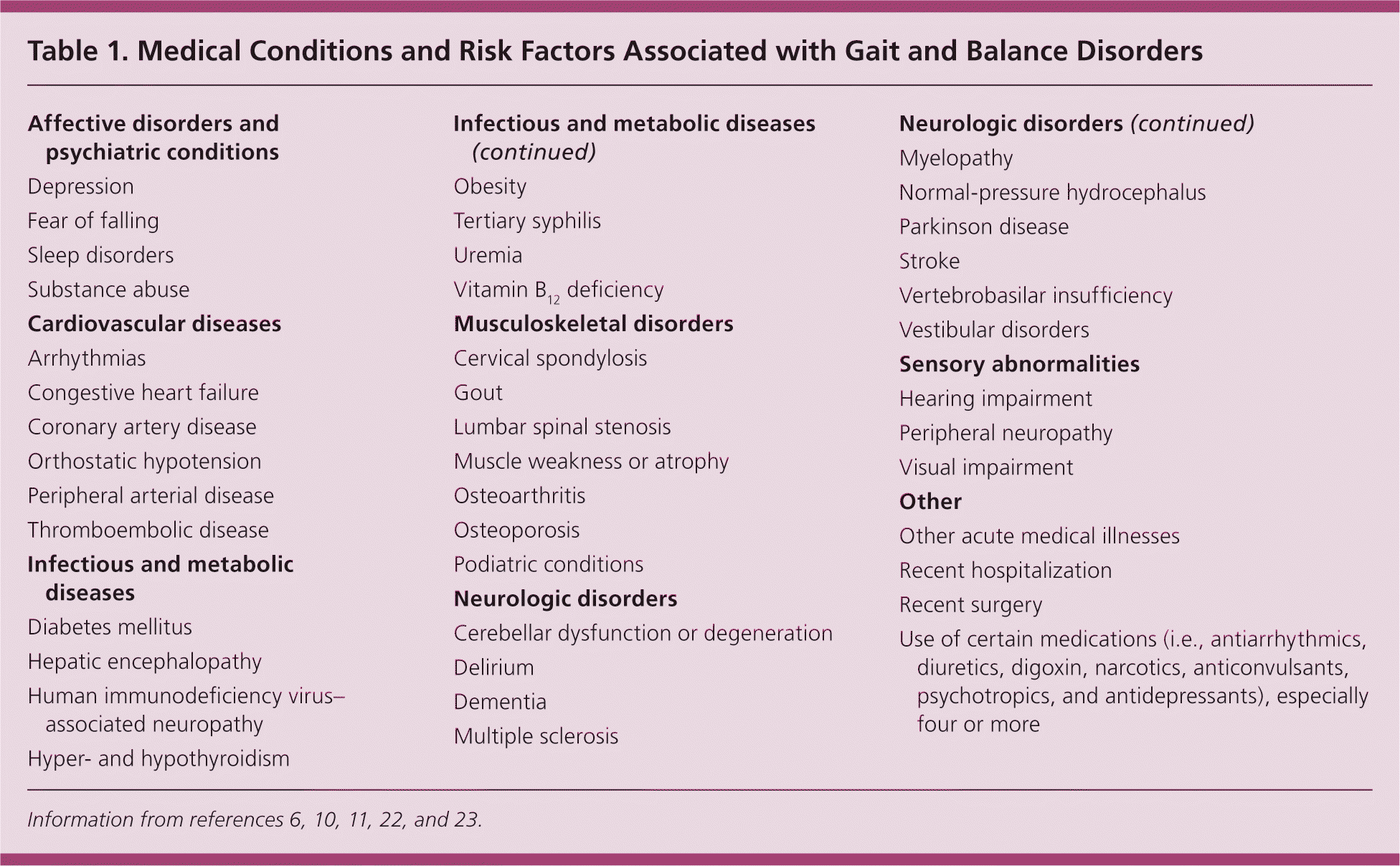
| Affective disorders and psychiatric conditions |
| Depression |
| Fear of falling |
| Sleep disorders |
| Substance abuse |
| Cardiovascular diseases |
| Arrhythmias |
| Congestive heart failure |
| Coronary artery disease |
| Orthostatic hypotension |
| Peripheral arterial disease |
| Thromboembolic disease |
| Infectious and metabolic diseases |
| Diabetes mellitus |
| Hepatic encephalopathy |
| Human immunodeficiency virus–associated neuropathy |
| Hyper- and hypothyroidism |
| Obesity |
| Tertiary syphilis |
| Uremia |
| Vitamin B12 deficiency |
| Musculoskeletal disorders |
| Cervical spondylosis |
| Gout |
| Lumbar spinal stenosis |
| Muscle weakness or atrophy |
| Osteoarthritis |
| Osteoporosis |
| Podiatric conditions |
| Neurologic disorders |
| Cerebellar dysfunction or degeneration |
| Delirium |
| Dementia |
| Multiple sclerosis |
| Myelopathy |
| Normal-pressure hydrocephalus |
| Parkinson disease |
| Stroke |
| Vertebrobasilar insufficiency |
| Vestibular disorders |
| Sensory abnormalities |
| Hearing impairment |
| Peripheral neuropathy |
| Visual impairment |
| Other |
| Other acute medical illnesses |
| Recent hospitalization |
| Recent surgery |
| Use of certain medications (i.e., antiarrhythmics, diuretics, digoxin, narcotics, anticonvulsants, psychotropics, and antidepressants), especially four or more |
In one study performed in a family medicine setting, gait and balance disorders were multifactorial in origin in 75 percent of older patients.14 In this study of patients with self-reported difficulty in walking, the most common problems identified included arthritis (37 percent) and orthostatic hypotension (9 percent).14 In a group of community-dwelling adults older than 88, joint pain was reported as the most common contributor to gait problems (32 percent), followed by several other causes, including stroke (1 percent), visual impairment (1 percent), and back or neck pain (0.5 percent).13 Older patients referred to a neurology clinic for evaluation of a gait disorder of unknown etiology were diagnosed with various neurologic conditions, including myelopathy (commonly related to cervical spondylosis), sensory abnormalities (either visual, vestibular, or proprioceptive dysfunction), multiple strokes, normal-pressure hydrocephalus, parkinsonism, and cerebellar disorders.6
Diagnosis
HISTORY AND PHYSICAL EXAMINATION
Because gait and balance disorders are major causes of falls, and predict future falls more consistently than other identified risk factors (likelihood ratio range, 1.7 to 2.4),27 evaluation of gait and balance is an essential step in identifying persons at increased risk of falling. In addition, patients who have fallen in the past year are significantly more likely to fall again (likelihood ratio range, 2.3 to 2.8).27 Guidelines on fall prevention recommend that physicians ask older persons (especially those who are frail or vulnerable) at least annually about falls, and ask about or examine for difficulties with gait and balance at least once.4,27–30 Older persons who report a fall should be asked about difficulties with gait and balance, and should be observed for any gait or balance dysfunctions.4,27–30 Patients who present to their physician after a fall, report recurrent falls, demonstrate gait and balance abnormalities, or report difficulties in walking or balance should undergo a comprehensive assessment.4,28–30
The evaluation of gait and balance disorders parallels the evaluation of falls9,28,29 and is described in Table 2.28,29,31,32 Patient problems (e.g., foot pain) and descriptions of difficulties with gait or balance (e.g., feeling unsteady) help frame the evaluation of gait and balance disorders. Associated symptoms can be helpful in identifying underlying conditions and narrowing the differential diagnosis31 (Table 310,12,15,31,33 ). Information regarding previous falls, including the circumstances surrounding the fall and related symptoms, should be sought. Caregivers may be able to provide valuable information about falls or difficulty with walking. It is also important to inquire about environmental hazards that commonly contribute to falls, including poor lighting, slippery surfaces, throw rugs, electrical cords, high clutter areas, steep stairways, low chairs, and lack of grab bars near the toilet and bathtub.32
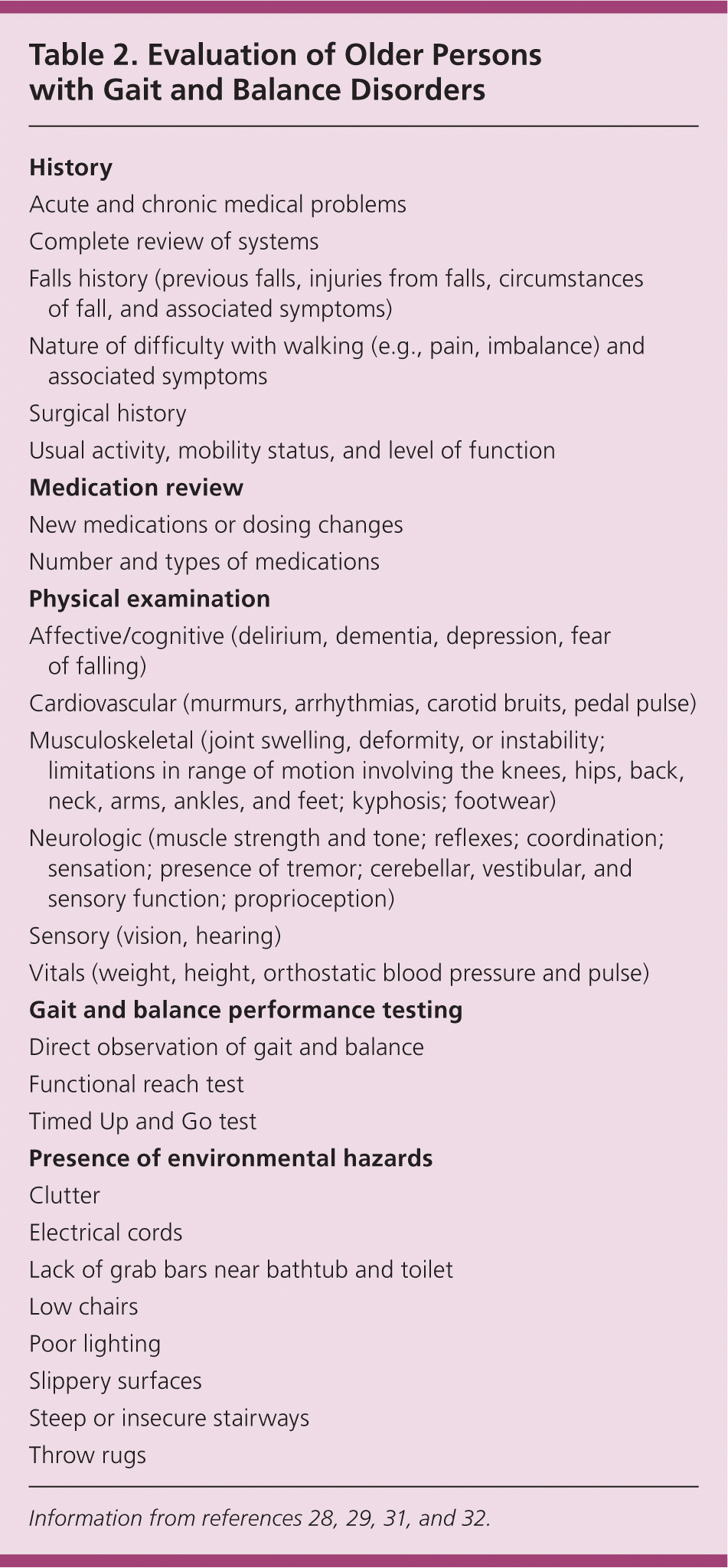
| History |
| Acute and chronic medical problems |
| Complete review of systems |
| Falls history (previous falls, injuries from falls, circumstances of fall, and associated symptoms) |
| Nature of difficulty with walking (e.g., pain, imbalance) and associated symptoms |
| Surgical history |
| Usual activity, mobility status, and level of function |
| Medication review |
| New medications or dosing changes |
| Number and types of medications |
| Physical examination |
| Affective/cognitive (delirium, dementia, depression, fear of falling) |
| Cardiovascular (murmurs, arrhythmias, carotid bruits, pedal pulse) |
| Musculoskeletal (joint swelling, deformity, or instability; limitations in range of motion involving the knees, hips, back, neck, arms, ankles, and feet; kyphosis; footwear) |
| Neurologic (muscle strength and tone; reflexes; coordination; sensation; presence of tremor; cerebellar, vestibular, and sensory function; proprioception) |
| Sensory (vision, hearing) |
| Vitals (weight, height, orthostatic blood pressure and pulse) |
| Gait and balance performance testing |
| Direct observation of gait and balance |
| Functional reach test |
| Timed Up and Go test |
| Presence of environmental hazards |
| Clutter |
| Electrical cords |
| Lack of grab bars near bathtub and toilet |
| Low chairs |
| Poor lighting |
| Slippery surfaces |
| Steep or insecure stairways |
| Throw rugs |
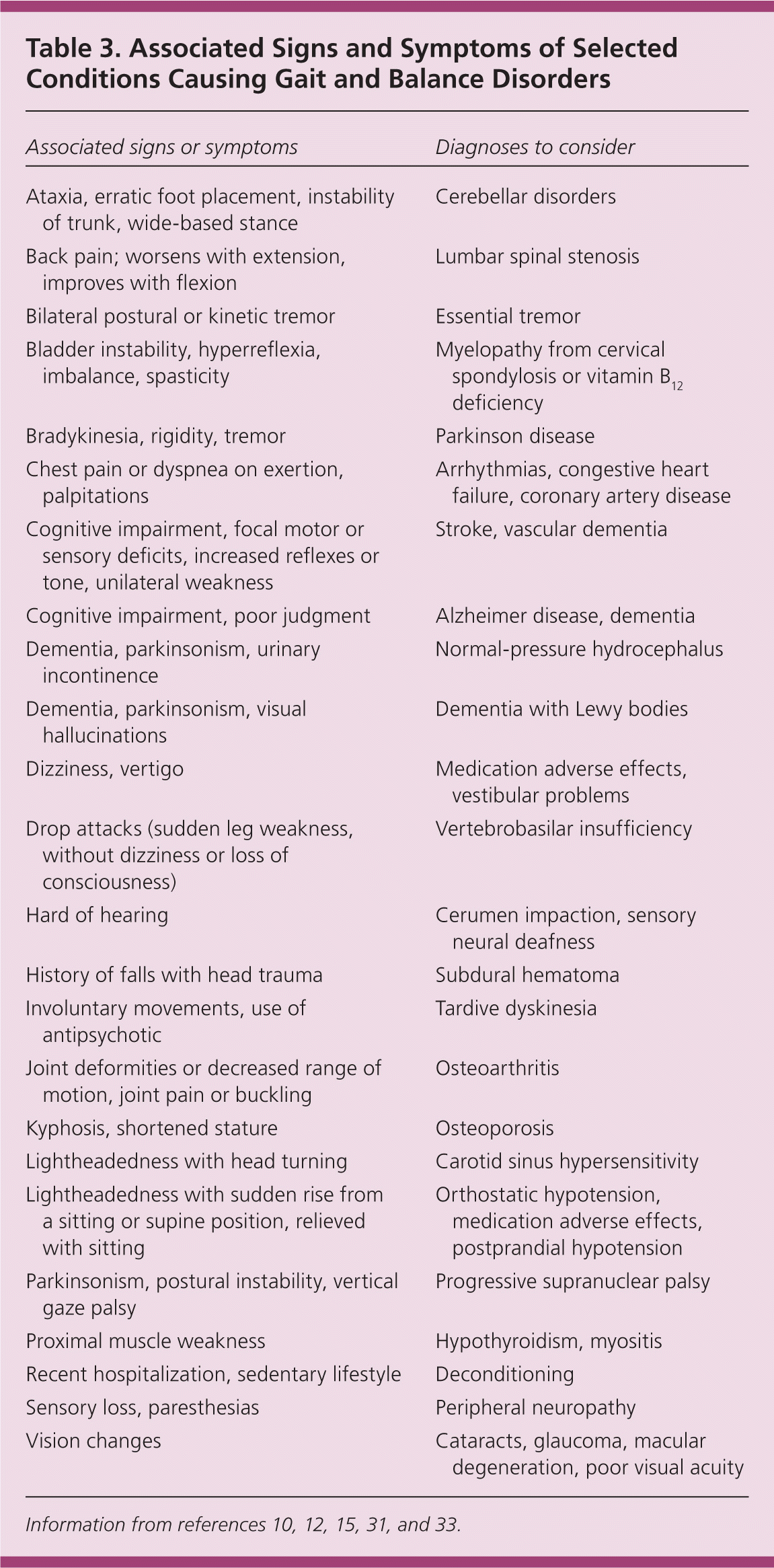
| Associated signs or symptoms | Diagnoses to consider |
|---|---|
| Ataxia, erratic foot placement, instability of trunk, wide-based stance | Cerebellar disorders |
| Back pain; worsens with extension, improves with flexion | Lumbar spinal stenosis |
| Bilateral postural or kinetic tremor | Essential tremor |
| Bladder instability, hyperreflexia, imbalance, spasticity | Myelopathy from cervical spondylosis or vitamin B12 deficiency |
| Bradykinesia, rigidity, tremor | Parkinson disease |
| Chest pain or dyspnea on exertion, palpitations | Arrhythmias, congestive heart failure, coronary artery disease |
| Cognitive impairment, focal motor or sensory deficits, increased reflexes or tone, unilateral weakness | Stroke, vascular dementia |
| Cognitive impairment, poor judgment | Alzheimer disease, dementia |
| Dementia, parkinsonism, urinary incontinence | Normal-pressure hydrocephalus |
| Dementia, parkinsonism, visual hallucinations | Dementia with Lewy bodies |
| Dizziness, vertigo | Medication adverse effects, vestibular problems |
| Drop attacks (sudden leg weakness, without dizziness or loss of consciousness) | Vertebrobasilar insufficiency |
| Hard of hearing | Cerumen impaction, sensory neural deafness |
| History of falls with head trauma | Subdural hematoma |
| Involuntary movements, use of antipsychotic | Tardive dyskinesia |
| Joint deformities or decreased range of motion, joint pain or buckling | Osteoarthritis |
| Kyphosis, shortened stature | Osteoporosis |
| Lightheadedness with head turning | Carotid sinus hypersensitivity |
| Lightheadedness with sudden rise from a sitting or supine position, relieved with sitting | Orthostatic hypotension, medication adverse effects, postprandial hypotension |
| Parkinsonism, postural instability, vertical gaze palsy | Progressive supranuclear palsy |
| Proximal muscle weakness | Hypothyroidism, myositis |
| Recent hospitalization, sedentary lifestyle | Deconditioning |
| Sensory loss, paresthesias | Peripheral neuropathy |
| Vision changes | Cataracts, glaucoma, macular degeneration, poor visual acuity |
A careful medical history and review of systems may help reveal factors contributing to gait and balance disorders. Reviewing medications is a critical aspect of a gait and balance evaluation, particularly recently added medications, those with dosing changes, and those with known adverse effects. Determining the patient's mobility status and functional level is helpful to quantify the current impairment, as well as the target recovery level. Mobility status can be assessed with the Functional Ambulation Classification scale, which includes the degree of human assistance needed to ambulate and types of surfaces the patient can negotiate (Table 4).34,35 The patient's functional level should be assessed by asking about independence in activities of daily living (e.g., bathing, dressing, eating, toileting) and instrumental activities of daily living (e.g., transportation, shopping, cooking, housework, laundry).
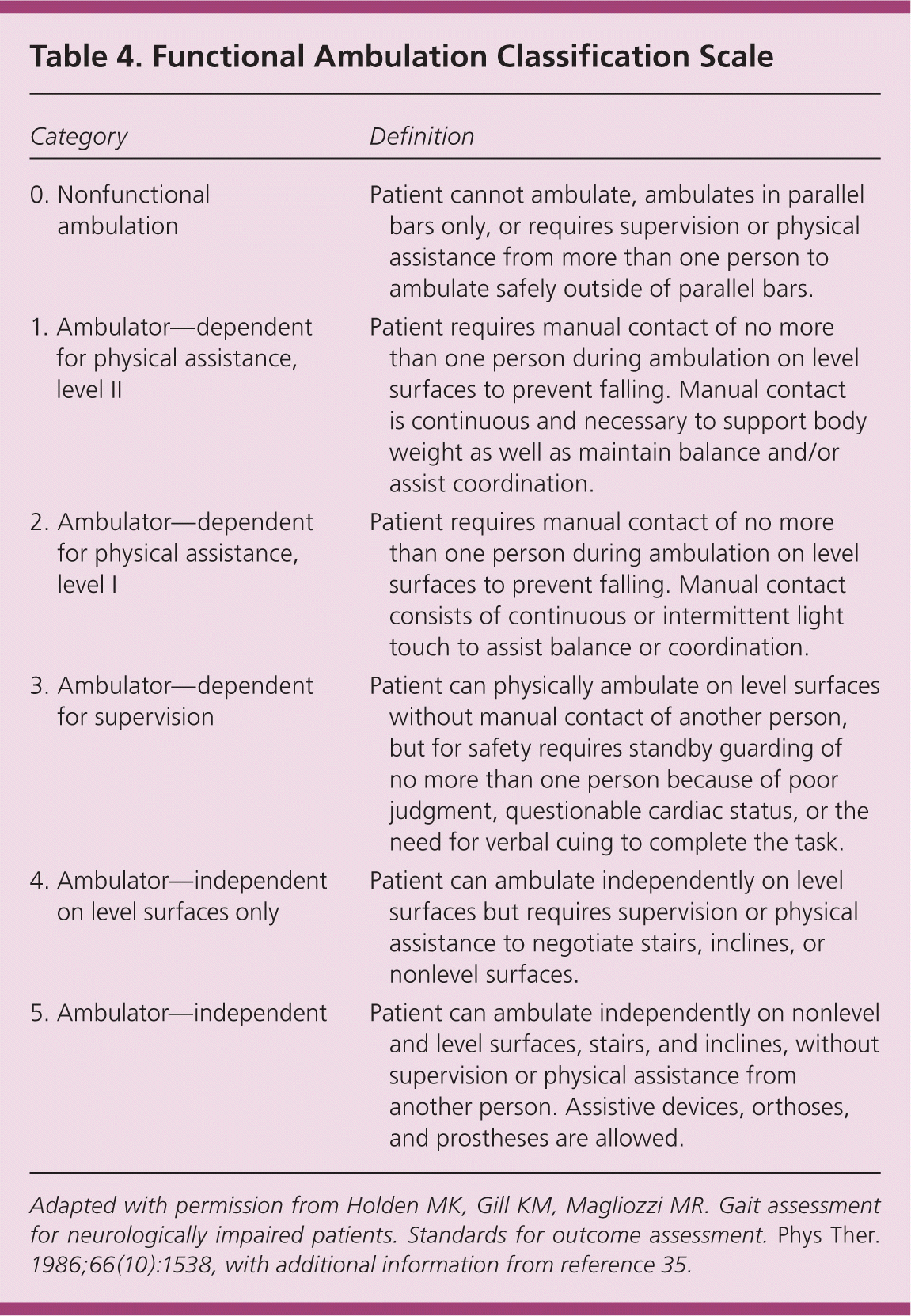
| Category | Definition |
|---|---|
| 0. Nonfunctional ambulation | Patient cannot ambulate, ambulates in parallel bars only, or requires supervision or physical assistance from more than one person to ambulate safely outside of parallel bars. |
| 1. Ambulator—dependent for physical assistance, level II | Patient requires manual contact of no more than one person during ambulation on level surfaces to prevent falling. Manual contact is continuous and necessary to support body weight as well as maintain balance and/or assist coordination. |
| 2. Ambulator—dependent for physical assistance, level I | Patient requires manual contact of no more than one person during ambulation on level surfaces to prevent falling. Manual contact consists of continuous or intermittent light touch to assist balance or coordination. |
| 3. Ambulator—dependent for supervision | Patient can physically ambulate on level surfaces without manual contact of another person, but for safety requires standby guarding of no more than one person because of poor judgment, questionable cardiac status, or the need for verbal cuing to complete the task. |
| 4. Ambulator—independent on level surfaces only | Patient can ambulate independently on level surfaces but requires supervision or physical assistance to negotiate stairs, inclines, or nonlevel surfaces. |
| 5. Ambulator—independent | Patient can ambulate independently on nonlevel and level surfaces, stairs, and inclines, without supervision or physical assistance from another person. Assistive devices, orthoses, and prostheses are allowed. |
On physical examination, patients should be evaluated for orthostatic hypotension, vision and hearing problems, and cardiovascular and pulmonary conditions. They should also be evaluated for joint deformity, swelling, instability, and limitations in range of motion involving the hips, knees, ankles, back, neck, arms, and feet. Posture should be examined, and footwear should be assessed for comfort, support, and stability. Physicians should look for focal neurologic deficits, and assess for muscle strength and tone, reflexes, sensation, proprioception, tremor, coordination, and cerebellar and vestibular function. Also, patients should have cognitive status evaluation and depression screening. Fear of falling can be assessed directly or using a validated questionnaire.36
Observation of gait should occur, which can include watching a patient enter and exit the examination room. Aspects of gait that should be evaluated include stance, posture, difficulties with initiation, velocity, step length, symmetry, cadence, fluidity of movements, instability, and need of assistance.33 Table 5 reviews the most common gait patterns encountered in the older population, along with associated signs and related causes.33 Abnormalities may be revealed by adding challenges to gait performance, such as having patients walk in tandem (toe to heel) and briefly on their toes and heels. The inability to perform a tandem walk has been found to predict the occurrence of falls.7
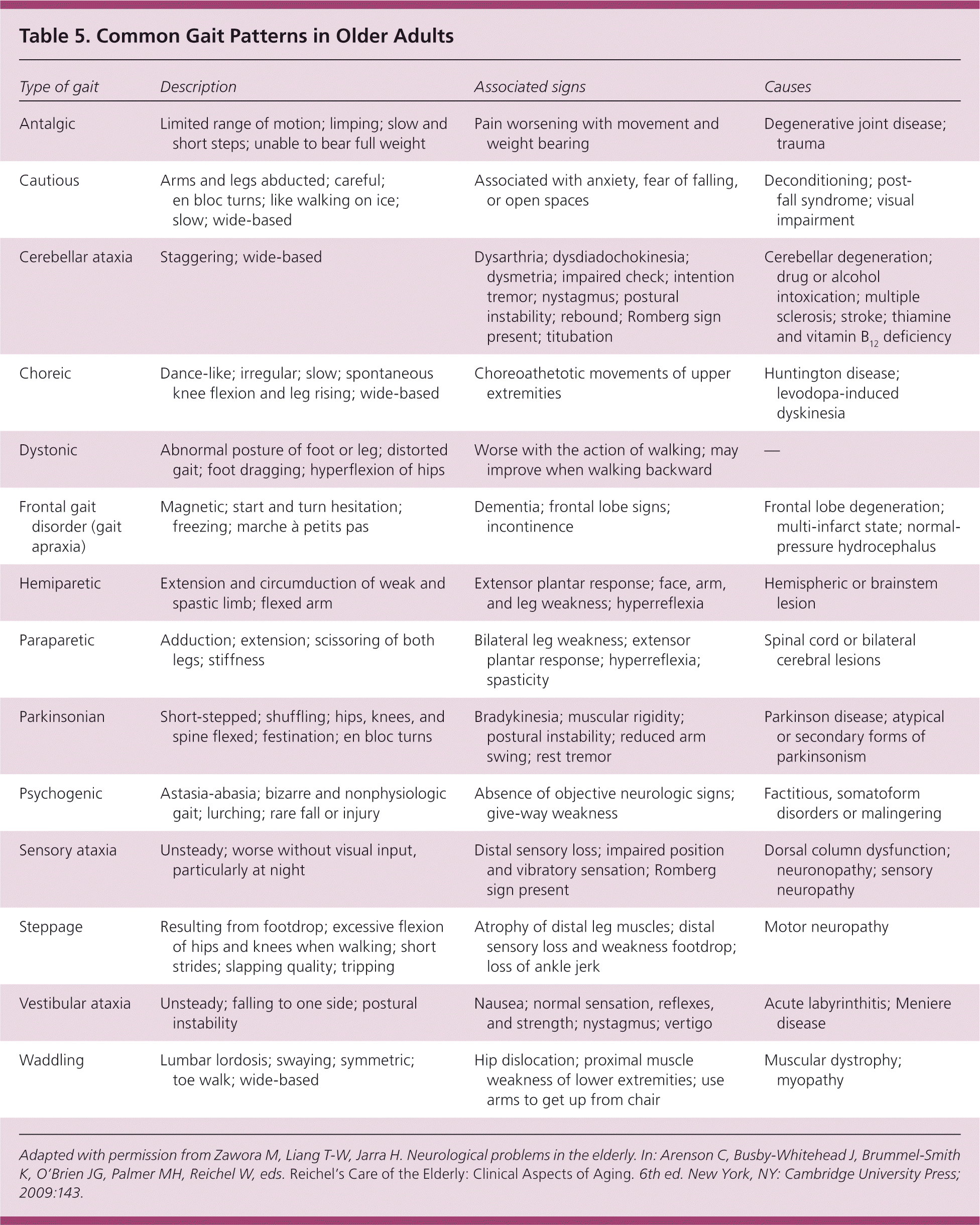
| Type of gait | Description | Associated signs | Causes |
|---|---|---|---|
| Antalgic | Limited range of motion; limping; slow and short steps; unable to bear full weight | Pain worsening with movement and weight bearing | Degenerative joint disease; trauma |
| Cautious | Arms and legs abducted; careful; en bloc turns; like walking on ice; slow; wide-based | Associated with anxiety, fear of falling, or open spaces | Deconditioning; post-fall syndrome; visual impairment |
| Cerebellar ataxia | Staggering; wide-based | Dysarthria; dysdiadochokinesia; dysmetria; impaired check; intention tremor; nystagmus; postural instability; rebound; Romberg sign present; titubation | Cerebellar degeneration; drug or alcohol intoxication; multiple sclerosis; stroke; thiamine deficiency and vitamin B12 deficiency |
| Choreic | Dance-like; irregular; slow; spontaneous knee flexion and leg rising; wide-based | Choreoathetotic movements of upper extremities | Huntington disease; levodopa-induced dyskinesia |
| Dystonic | Abnormal posture of foot or leg; distorted gait; foot dragging; hyperflexion of hips | Worse with the action of walking; may improve when walking backward | — |
| Frontal gait disorder (gait apraxia) | Magnetic; start and turn hesitation; freezing; marche à petits pas | Dementia; frontal lobe signs; incontinence | Frontal lobe degeneration; multi-infarct state; normal-pressure hydrocephalus |
| Hemiparetic | Extension and circumduction of weak and spastic limb; flexed arm | Extensor plantar response; face, arm, and leg weakness; hyperreflexia | Hemispheric or brainstem lesion |
| Paraparetic | Adduction; extension; scissoring of both legs; stiffness | Bilateral leg weakness; extensor plantar response; hyperreflexia; spasticity | Spinal cord or bilateral cerebral lesions |
| Parkinsonian | Short-stepped; shuffling; hips, knees, and spine flexed; festination; en bloc turns | Bradykinesia; muscular rigidity; postural instability; reduced arm swing; rest tremor | Parkinson disease; atypical or secondary forms of parkinsonism |
| Psychogenic | Astasia-abasia; bizarre and nonphysiologic gait; lurching; rare fall or injury | Absence of objective neurologic signs; give-way weakness | Factitious, somatoform disorders or malingering |
| Sensory ataxia | Unsteady; worse without visual input, particularly at night | Distal sensory loss; impaired position and vibratory sensation; Romberg sign present | Dorsal column dysfunction; neuronopathy; sensory neuropathy |
| Steppage | Resulting from footdrop; excessive flexion of hips and knees when walking; short strides; slapping quality; tripping | Atrophy of distal leg muscles; distal sensory loss and weakness footdrop; loss of ankle jerk | Motor neuropathy |
| Vestibular ataxia | Unsteady; falling to one side; postural instability | Nausea; normal sensation, reflexes, and strength; nystagmus; vertigo | Acute labyrinthitis; Meniere disease |
| Waddling | Lumbar lordosis; swaying; symmetric; toe walk; wide-based | Hip dislocation; proximal muscle weakness of lower extremities; use arms to get up from chair | Muscular dystrophy; myopathy |
SPECIFIC CLINICAL TESTS
Older persons who report a fall should have an assessment of gait and balance using one of the available evaluation methods, including the Timed Up and Go test, the Berg Balance Scale, or the Performance-Oriented Mobility Assessment (POMA).29 There are no adequate prospective studies that support selection of a specific test for gait and balance29; however, the Berg Balance Scale and POMA require 10 to 20 minutes to administer. In contrast, the Timed Up and Go test is a reliable diagnostic tool for gait and balance disorders, and is quick to administer.37,38 Patients are timed as they rise from a chair without using their arms, walk 3 meters, turn, return to the chair, and sit down. They are allowed to use their usual walking aid. A score of less than 10 seconds is considered normal, and 14 seconds or more is abnormal and associated with an increased risk of falls.38 Patients who perform the task in more than 20 seconds usually have more severe gait impairment. The Timed Up and Go test is a sensitive (87 percent) and specific (87 percent) measure for identifying older persons who are prone to falls.39 It correlates well with other more-detailed scales,40,41 but is quicker and easier to perform.42 Persons who have difficulty or demonstrate unsteadiness performing the Timed Up and Go test require further assessment, usually with a physical therapist, to help elucidate gait impairments and related functional limitations.
The functional reach test is another reliable, valid, and quick diagnostic test that evaluates balance and postural stability.40,43 The patient should stand with his or her feet shoulderwidth apart and raise one arm 90 degrees to the front of his or her body. Then, without moving his or her feet, the patient should reach as far forward as possible while still maintaining stability.44 The maximum distance the patient can reach forward beyond arm's length should be measured using a ruler fixed at shoulder height. Generally, the inability to reach at least 7 inches is highly predictive of falls in older persons.45
OTHER DIAGNOSTIC TESTING
The role of laboratory testing and diagnostic evaluation for gait and balance disorders has not been well studied. Consider a complete blood count; thyroid function test; rapid plasma reagin test; and electrolyte, blood urea nitrogen, creatinine, glucose, and vitamin B12 levels as part of the initial evaluation in patients without a clear diagnosis following the history and physical examination. Other studies may be useful when history and physical examination raise suspicion for a specific abnormality.
Interventions
A multifactorial evaluation followed by targeted interventions for identified contributing factors can reduce falls by 30 to 40 percent46 and is the most effective strategy for falls prevention.46–49 However, evidence on the effectiveness of interventions for gait and balance disorders is limited because of the lack of standardized outcome measures determining gait and balance abilities.
Because most gait and balance disorders in older persons are multifactorial in origin, they usually require several modes of treatment to restore, maintain, or improve functional capacity.50 In most cases, it is unlikely that gait disorders are reversible; however, modest improvements in gait and balance may be achievable, and interventions may impact important functional outcomes, such as reduction in rates of falls, fear of falling, weight-bearing pain, and overall limitations in mobility.
Many gait disorders are caused by chronic medical conditions that may be alleviated to some extent through targeted medical or surgical interventions. Gait disorders secondary to conditions such as arthritis, orthostatic hypotension, Parkinson disease, vitamin B12 deficiency, hypothyroidism, heart rate or rhythm abnormalities, or depression may respond to medical therapies.16,23,29
Although data are limited, surgery may improve gait for patients with cervical spondylotic myelopathy,51 lumbar spinal stenosis,52 normal-pressure hydrocephalus,53 or arthritis of the knee or hip.54,55 Insertion of pacemakers in patients with carotid sinus hypersensitivity and first eye cataract surgery have been shown to reduce the rate of falls.48,49,56,57 Improving sensory input, with visual correction or hearing aids, may augment gait and function. Reduction in the number of medications or removing medications causing adverse effects can improve gait disorders and reduce the risk of falling.24,25 For instance, the gradual withdrawal of psychotropic medications reduces the rate of falls (relative risk = 0.34; 95% confidence interval, 0.16 to 0.73).49 The use of mobility aids, such as canes or walkers (properly fitted to the person), can reduce load on a painful joint and increase stability. Although evidence supporting the use of home environment assessment and intervention alone as a strategy to reduce falls in the general older population is mixed, evidence strongly supports home environment assessment and intervention as part of a multifactorial fall prevention program.29,58 In particular, home safety programs provided by a trained health care professional appear to be effective for persons at high risk of falls, such as those with a history of falls or other fall risk factors.29,48,49,58
Other generally effective options for patients with gait and balance disorders include exercise and physical therapy.48,49,59–63 Exercise programs may target strength, balance, flexibility, or endurance. A Cochrane review found that programs containing two or more of these components reduce the rate of falls and number of persons falling.48,49 Exercising in supervised groups, particularly tai chi, and carrying out individually prescribed exercise programs at home are effective.48,49 A variety of exercise interventions, including walking, functional exercises, muscle strengthening, and multiple exercise types, have also been found to significantly improve balance.63
